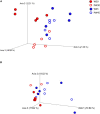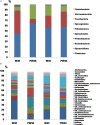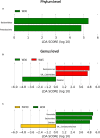Weaning Age Affects the Development of the Ruminal Bacterial and Archaeal Community in Hu Lambs During Early Life
- PMID: 33833741
- PMCID: PMC8021712
- DOI: 10.3389/fmicb.2021.636865
Weaning Age Affects the Development of the Ruminal Bacterial and Archaeal Community in Hu Lambs During Early Life
Abstract
Weaning plays an important role in many animal processes, including the development of the rumen microbiota in ruminants. Attaining a better understanding of the development of the rumen microbial community at different weaning stages can aid the identification of the optimal weaning age. We investigated the effects of weaning age on ruminal bacterial and archaeal communities in Hu lambs. Thirty male Hu lambs were randomly assigned to two weaning-age groups: a group weaned at 30 days of age (W30) and a group weaned at 45 days of age (W45), with each group having five replicate pens. On the weaning day (day 30 for W30 and day 45 for W45) and at 5 days postweaning [day 35 for W30 (PW30) and day 50 for W45 (PW45)], one lamb from each replicate was randomly selected and sacrificed. Rumen contents were collected to examine the ruminal microbiota. Compared to W30, PW30 had a decreased relative abundance of Bacteroidetes. At genus level, the extended milk replacer feeding (W45 vs. W30) increased the relative abundance of Ruminococcus while decreased that of Prevotella and Dialister. Compared to W30, PW30 exhibited decreased relative abundances of Prevotella, Dialister and Bacteroides but an increased unclassified Coriobacteriaceae. No significant difference was noted in the detected archaeal taxa among the animals. The function "biosynthesis of secondary metabolites" was less predominant in PW30 than in W30, whereas the opposite held true for "metabolism of cofactors and vitamins." Some bacterial genera were significantly correlated with rumen volatile fatty acid (VFA) concentration or other animal measures, including negative correlations between ruminal VFA concentration and unclassified Mogibacteriaceae and unclassified Veillonellaceae; positive correlations of ruminal papillae length with Fibrobacter and unclassified Lachnospiraceae, but negative correlations with Mitsuokella and Succiniclasticum; and negative correlations between plasma D-lactate concentration and Prevotella, unclassified Paraprevotellaceae, and Desulfovibrio. Our results revealed that the ruminal bacterial community underwent larger changes over time in lambs weaned at 30 days of age than in lambs weaned half a month later. Thus, extending milk replacer feeding to 45 days weaning was recommended from the perspective of the rumen microbial community in the Hu lamb industry.
Keywords: archaea; bacteria; lamb; postweaning; rumen; weaning age; weaning stress.
Copyright © 2021 Mao, Zhang, Yun, Ji, Jin, Wang and Yu.
Conflict of interest statement
The authors declare that the research was conducted in the absence of any commercial or financial relationships that could be construed as a potential conflict of interest.
Figures





Similar articles
-
Starter feeding altered ruminal epithelial bacterial communities and some key immune-related genes' expression before weaning in lambs.J Anim Sci. 2017 Feb;95(2):910-921. doi: 10.2527/jas.2016.0985. J Anim Sci. 2017. PMID: 28380582
-
Alfalfa Intervention Alters Rumen Microbial Community Development in Hu Lambs During Early Life.Front Microbiol. 2018 Mar 27;9:574. doi: 10.3389/fmicb.2018.00574. eCollection 2018. Front Microbiol. 2018. PMID: 29636743 Free PMC article.
-
Effects of whole corn high-grain diet feeding on ruminal bacterial community and epithelial gene expression related to VFA absorption and metabolism in fattening lambs.J Anim Sci. 2022 Mar 1;100(3):skac056. doi: 10.1093/jas/skac056. J Anim Sci. 2022. PMID: 35213698 Free PMC article.
-
The functional development of the rumen is influenced by weaning and associated with ruminal microbiota in lambs.Anim Biotechnol. 2022 Aug;33(4):612-628. doi: 10.1080/10495398.2020.1812618. Epub 2020 Sep 2. Anim Biotechnol. 2022. PMID: 32876516
-
Weaning Ages Do Not Affect the Overall Growth or Carcass Traits of Hu Sheep.Animals (Basel). 2019 Jun 14;9(6):356. doi: 10.3390/ani9060356. Animals (Basel). 2019. PMID: 31207948 Free PMC article.
Cited by
-
Dietary spirulina supplementation modifies rumen development, fermentation and bacteria composition in Hu sheep when consuming high-fat dietary.Front Vet Sci. 2023 Jan 30;10:1001621. doi: 10.3389/fvets.2023.1001621. eCollection 2023. Front Vet Sci. 2023. PMID: 36798143 Free PMC article.
-
Average Daily Gain in Lambs Weaned at 60 Days of Age Is Correlated with Rumen and Rectum Microbiota.Microorganisms. 2023 Jan 30;11(2):348. doi: 10.3390/microorganisms11020348. Microorganisms. 2023. PMID: 36838313 Free PMC article.
-
Effects of milk replacer feeding level on growth performance, rumen development and the ruminal bacterial community in lambs.Front Microbiol. 2023 Jan 10;13:1069964. doi: 10.3389/fmicb.2022.1069964. eCollection 2022. Front Microbiol. 2023. PMID: 36704552 Free PMC article.
-
Stress Factors and Their Effects on Productivity in Sheep.Animals (Basel). 2023 Aug 31;13(17):2769. doi: 10.3390/ani13172769. Animals (Basel). 2023. PMID: 37685033 Free PMC article. Review.
-
The Temporal Dynamics of Rumen Microbiota in Early Weaned Lambs.Microorganisms. 2022 Jan 11;10(1):144. doi: 10.3390/microorganisms10010144. Microorganisms. 2022. PMID: 35056593 Free PMC article.
References
-
- Bryant M. P. (1986). “Genus IV. Butyrivibrio Bryant and small 1956, 18, emend. Moore, Johnson and Holdeman 1976, 241,” in Bergey’s Manual of Systematic Bacteriology, Vol. 2 eds Sneath P. H. A., Mair N. S., Sharpe M. E., Holt J. G. (Baltimore, MD: Williams &Wilkins; ), 1376–1379.
-
- Ezaki T. (2015). “Ruminococcus,” in Bergey’s Manual of Systematics of Archaea and Bacteria, ed. Whitman W. B. (Hoboken, NJ: JohnWiley & Sons; ). 10.1002/9781118960608.gbm00678 - DOI
LinkOut - more resources
Full Text Sources
Other Literature Sources

